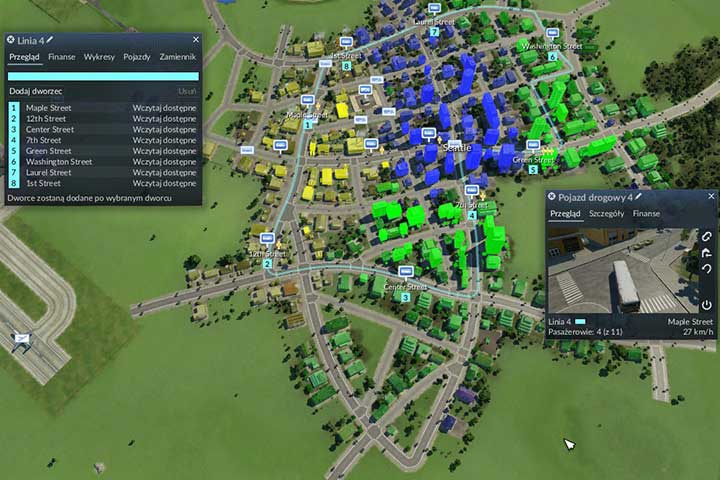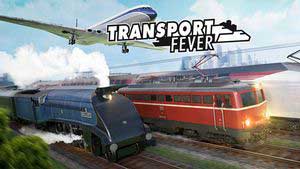Transporting passengers, resources and goods Transport Fever Guide
Last update: 28 November 2016
Transport Fever revolves exclusively around transportation and building an effective network of connections, which use various types of transport. It is worth knowing more about the way cities and citizens work, and about the rules of your cooperation with mines, farms and other facilities. As it is, the game forces you to create complete, enclosed chains of production. Making loops, or creating connections up to a certain point of the production process will not only be ineffective and averagely profitable, but could also be a source of major costs for your enterprise.
Passengers

The game offers us a citizen transport system, quite similar to the system in another game - Cities In Motion. The mentioned titled had quite a complicated system, here it has been simplified a bit. Each city has three types of urban areas: green - the residential area, blue - the commercial area, yellow - the industrial zone. Cities usually generate the buildings of the same type in clusters, which in turn divides the city into something similar to districts. Each citizen has his own workplace and a favourite store, which he will visit in his spare time. To encourage people to use your lines, you have to create a network which connects all of their points of interest.
Passengers will get off on stops, which are closest to their destination point. Sometimes, you will encounter a situation, where e.g. the bus is always full, because the citizens want to get to a store on the other side of the city. This way no one is able to enter the bus until they reach the store. In such cases, it is worth reorganizing the connection, adding more buses or other types of transportation or creating an additional connection. The frequency with which a given stop is visited by a transport is also extremely important. If it is too low, the line may be unattractive to passengers and nobody will show up on the stops.

If you create several connections in a city, make sure that they have one common point, which they will all use. The citizens will then be able to switch between the lines, allowing them to use the line which is the most suitable for their needs. It is best to adopt such a system, if you intend to transport the citizens to another city. In the case of buses, it is worth creating a terminal (it is best to create one on the outskirts of the city, so the buses are not stuck in traffic) or a stop or a small terminal by the airport or the train station. Then, the passengers will be transported to another city and will be considered tourists. The number of passengers using inter-city connections will rise tremendously, if the cities have their own, internal connections. You will often be earning pennies, or even losing money, on the internal connections in a given city, but you will earn a lot more on the inter-city connections thanks to the internal ones.
Resources, intermediate goods and goods.
You will encounter a vast amount of things to transport. It is very important that you do not focus on transporting just one product, or on fulfilling the demand of just one factory. It is much more efficient to focus on creating a complete production cycle. It will yield much greater profits, you will avoid trouble later on and it will also serve as a plan for the further development of your enterprise.

We can distinguish three groups/types of objects to transport. Resources, the things which are grown or mined, e.g. grain, stone, iron, coal, etc. In other words, everything that is at the beginning of the production chain. Then there are the so-called intermediate goods. They cannot be sold in a city, but they are absolutely necessary to create the final products, they are e.g. steel (made from iron and coal) or boards (resource: logs). From resources and intermediate goods we can create the final objects to transport - goods or commodities. These objects have to be transported to cities.
There are two groups of commodities, there are six of them in total. The blue commercial zone has demand for: food, tools and "goods". The yellow industrial zone has demand for: fuel, machines and construction materials. It is worth mentioning, that if you fulfill the demand for at least one of the goods, for each of the city's zones, than you will contribute to the city's development, and in turn increase the overall market growth and the citizen population in the city.
Some factories require several resources in order to produce their specific product, e.g. the previously mentioned steel, where you need to transport both iron and coal. Others, allow several different combinations, e.g. the food processing plant requires grain, cattle, or both of these resources, in order to produce food. There are also factories, which have demand for resources, intermediate goods or even goods and they are the endpoints of the production chain. That means they use up the delivered products. You will usually encounter such points in campaign missions, in free mode there are no such simplifications.

Why is creating a complete transport chain important ? If you pick a certain production point, factory or city, you will see the production/consumption limits. If you start importing too many production components, but you do not export enough of the final product, than the factory will cease production at some point and the extraction point will stop functioning. Example: you are transporting cattle and grain to a bakery/meat processing plant, which produces food, a commodity which you can transport to the city. However, you have decided not to create a connection to the city yet.
After some time, the processing plant will be filled with food products. Then, the demand for cattle will disappear (the demand for grain will increase if you have transported it in low quantities), and your transports will be waiting on empty stations. This situation will not be upon you immediately (each factory has its own storage capacity, which you can fill up), but it is best to consider this in advance. These do not have to be huge lines, one or two trucks if the distance is short, or a small train, should be enough. If several lines are using the same production point, it may be hard to see what exactly is the cause of the problem. Make sure not to choose the option of fully loading your transports in such cases.
A certain point does not share its resources/goods with a line which has no demand. However, if you see, that the initial station has too many resources/goods, check if it might be worth it to add a few additional trucks or carts. You will then utilize the full capacity of the production point, which will in turn yield higher profits. Usually, this also results in the expansion of the transport fleet on every line that is a part of that specific transport chain.
